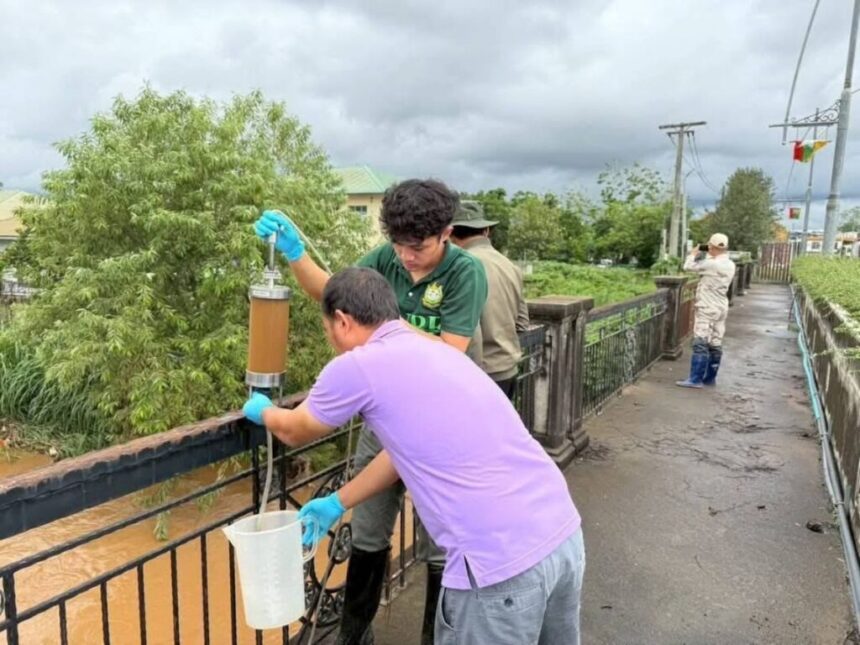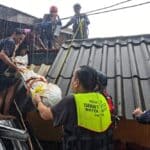CHIANG RAI – The Pollution Control Department (PCD) carried out its fifth round of water quality checks on the Kok River from 9 to 13 June 2025. The results show that the levels of arsenic in both the Kok and Sai Rivers, close to the Myanmar border in Mae Ai District, Chiang Mai, are above the safety standard.
These findings highlight a connection between high arsenic levels and unusual turbidity, especially after heavy rainfall. Sediment dredging and increased river flow have raised both turbidity and arsenic measurements. Mining activities across the border in Myanmar may be contributing to this contamination.
PCD plans to continue collecting samples throughout 2025, taking water samples twice a month and sediment samples once a month from May to September.
In response to the ongoing issue of murky water in the Kok River, the PCD, under the Ministry of Natural Resources and Environment, has set up monitoring points at 15 locations along the Kok River (KK01–KK15) and key tributaries including the Fang River (FA01), Lao River (LA01), Korn River (KO01), and Suai River (SU01).
There are also checkpoints on the Sai River at three spots (SA01–SA03), the Ruak River (RU01–RU02), and the Mekong River at three points (NK01–NK03) in Chiang Mai and Chiang Rai provinces. The monitoring plan for the 2025 fiscal year covers March to September, with water samples collected twice a month and sediment samples monthly from May to September.
Recent water quality tests from the fifth round, held from 9 to 13 June 2025, show the following results.
Kok River: Arsenic Levels Above Standard
From the Thai-Myanmar border in Mae Ai, Chiang Mai, down to Chiang Rai City (KK01–KK09), every testing point on the Kok River recorded arsenic levels above the safety threshold. Downstream, from the Chiang Rai weir through Ban Saeo, Chiang Saen (KK10–KK15), most points met the standard except the Rim Kok-Wiang Nuea Ruam Jai Bridge (KK11), which was slightly above the limit (standard: 0.010 mg/L).
- KK01 (Thai-Myanmar border, Tha Ton, Mae Ai, Chiang Mai): 0.025 mg/L
- KK02 (Friendship Bridge, Mae Na Wang-Tha Ton, Mae Ai): 0.022 mg/L
- KK03 (Ban Mae Salak Bridge, Mae Ai, Chiang Mai): 0.017 mg/L
- KK04 (Ban Ja Dae, Moo 6, Doi Hang, Chiang Rai City): 0.047 mg/L
- KK05 (Mae Yao-Doi Hang Friendship Bridge, Chiang Rai City): 0.036 mg/L
- KK06 (Ban Pong Na Kham, Doi Hang, Chiang Rai City): 0.033 mg/L
- KK07 (Kok River Bridge, Doi Hang, Chiang Rai City): 0.021 mg/L
- KK08 (Mae Fah Luang Bridge, Rob Wiang, Chiang Rai City): 0.028 mg/L
- KK09 (Chaloem Phra Kiat 1 Bridge, Rob Wiang, Chiang Rai City): 0.021 mg/L
- KK10 (Chiang Rai Weir, Rob Wiang, Chiang Rai City): <0.010 mg/L
- KK11 (Rim Kok-Wiang Nuea Ruam Jai Bridge, Wiang Chai, Chiang Rai): 0.011 mg/L
- KK12 (Yonok Nak Nakhon Bridge, Mae Khao Tom, Chiang Rai City): <0.010 mg/L
- KK13 (Tha Khao Pluak, Mae Chan): <0.010 mg/L
- KK14 (Nong Pa Kor, Doi Luang): <0.010 mg/L
- KK15 (Ban Saeo, Chiang Saen): <0.010 mg/L
Tributaries to the Kok River: Safe Levels
Water from tributaries flowing into the Kok River (Fang, Korn, Suai, and Lao Rivers) meets safety standards. These reference points and tributaries remain within safe limits for arsenic.
Sai River: Arsenic Above Standard at All Points
All three monitoring points on the Sai River reported arsenic above the acceptable level.
- SA01 (Ban Hua Fai, Mae Sai, Chiang Rai): 0.041 mg/L
- SA02 (Second Sai River Friendship Bridge, Mae Sai): 0.044 mg/L
- SA03 (Ban Pa Sang Ngam, Moo 6, Ko Chang, Mae Sai): 0.029 mg/L
Ruak River: Arsenic Above Standard at Both Points
Both sites on the Ruak River had arsenic levels higher than permitted.
- RU01 (Ko Chang Water Pumping Station, Provincial Waterworks, Mae Sai): 0.024 mg/L
- RU02 (Wiang, Chiang Saen, outflow to Mekong): 0.012 mg/L
Mekong River: High Arsenic at All Testing Points
The fifth round added a new collection point at the Golden Triangle permanent border crossing (NK01). All three Mekong River sites showed arsenic above the standard.
- NK01 (Golden Triangle border crossing, Wiang, Chiang Saen): 0.045 mg/L
- NK02 (Wiang, Chiang Saen): 0.044 mg/L
- NK03 (Ban Sop Kok, Ban Saeo, Chiang Saen): 0.036 mg/L
Analysis
- Water near the Myanmar border at both the Kok and Sai Rivers consistently recorded high turbidity and arsenic. This trend points to the strong influence of mining activities across the border.
- The detection of high arsenic in the Mekong is likely linked to water from the Sai and Ruak Rivers joining the Mekong, as all points along this route showed elevated readings. Additional checks on water flowing in from the Lao side of the Mekong would give a clearer picture.
- The PCD tested filtered and unfiltered water samples. All filtered samples from the Kok, Sai, and Mekong Rivers showed arsenic below 0.01 mg/L. Unfiltered samples, however, matched the high levels in the main report. This suggests that in these rivers, arsenic tends to cling to suspended solids more than remain dissolved.
- Arsenic levels appeared to increase with turbidity. The latest tests found very cloudy water and strong currents, which raised turbidity and arsenic content. Some heavy metals also exceeded standards at certain sites. Rainfall and flash flooding also contributed to higher turbidity. In particular, sites from Ban Ja Dae (Doi Hang, Chiang Rai City, KK04) to the Kok River Bridge (Doi Hang, Chiang Rai City, KK08) had heavy rain before sample collection, resulting in higher turbidity and arsenic than upstream border points (Tha Ton, Mae Ai, Chiang Mai, KK01–KK03), where there was no rainfall disturbance.
- Dredging of sediment in the Kok, Sai, and Ruak Rivers for flood prevention has also disturbed riverbeds, causing higher turbidity and more arsenic in the water.
The PCD will continue to monitor water quality regularly to track changes and support solutions for river pollution. This ongoing work helps protect local people who rely on these water sources.














